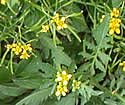Rorippa sylvestris (Creeping Yellow-cress)
| Also known as: | |
|---|---|
| Genus: | Rorippa |
| Family: | Brassicaceae (Mustard) |
| Life cycle: | perennial |
| Origin: | Europe, Asia |
| Status: |
|
| Habitat: | sun; wet ditches, wet meadows, along shores, cultivated fields, waste places |
| Bloom season: | June - September |
| Plant height: | 1 to 2 feet |
| Wetland Indicator Status: | GP: FACW MW: OBL NCNE: OBL |
| MN county distribution (click map to enlarge): |  |
| National distribution (click map to enlarge): |  |
Pick an image for a larger view. See the glossary for icon descriptions.
Detailed Information
Flower: 

![[photo of flowers]](/udata/r9ndp23q/pd/rorippa-sylvestris-803-t.jpg) Elongating clusters of stalked flowers at the end of branching stems. The yellow flowers are ~¼ inch across, forming at the tip of the expanding raceme, the 4 petals 3 to 5 mm long, rounded, spatula shaped, twice as long as the sepals, the narrowed base of the petals creating a wide gap between them.
Elongating clusters of stalked flowers at the end of branching stems. The yellow flowers are ~¼ inch across, forming at the tip of the expanding raceme, the 4 petals 3 to 5 mm long, rounded, spatula shaped, twice as long as the sepals, the narrowed base of the petals creating a wide gap between them.
Leaves and stems: 



![[photo of leaves]](/udata/r9ndp23q/pd/rorippa-sylvestris-005-t.jpg) Young plants form basal rosettes that disappear after the first year. Basal and lower stem leaves are oblong in outline, up to 8 inches (to 20 cm) long and ¾ inch wide, deeply divided into lobes that may be further lobed or have coarsely toothed edges. Leaves are hairless and become smaller and the divisions narrower as they ascend the stem. Stems are erect to ascending to prostrate, usually branched, ribbed, hairless or with sparse hairs on the lower stem. Plants can form dense colonies from creeping, underground stems (rhizomes).
Young plants form basal rosettes that disappear after the first year. Basal and lower stem leaves are oblong in outline, up to 8 inches (to 20 cm) long and ¾ inch wide, deeply divided into lobes that may be further lobed or have coarsely toothed edges. Leaves are hairless and become smaller and the divisions narrower as they ascend the stem. Stems are erect to ascending to prostrate, usually branched, ribbed, hairless or with sparse hairs on the lower stem. Plants can form dense colonies from creeping, underground stems (rhizomes).
Fruit: 
![[photo of fruit]](/udata/r9ndp23q/pd/rorippa-sylvestris-002-t.jpg) Fruit is a slender green pod up to ½ inch (10 to 15 mm) long, mostly straight, angled out and somewhat up from the stalk.
Fruit is a slender green pod up to ½ inch (10 to 15 mm) long, mostly straight, angled out and somewhat up from the stalk.
Notes:
Native to Europe and Asia and now widely established throughout North America, Rorippa sylvestris can be confused with the native annual Bog Yellow-cress (Rorippa palutris). Creeping Yellow-cress however is a perennial, forming dense colonies, its flowers are over twice the size of R. palustris, and its mature fruit longer and more slender. All three of our own observations and 1 of 6 herbarium records were from nursery production fields - a high risk pathway for this weed.
Native Plant Nurseries, Restoration and Landscaping Services ↓
More photos
Photos by Peter M. Dziuk taken in Washington County.
Comments
Have you seen this plant in Minnesota, or have any other comments about it?
on: 2018-08-31 11:31:59
I think a more detailed survey of this species should be done. I find this quite common in our open, lowland fields in early summer.
on: 2020-07-01 14:53:50
Creeping yellow cress seems to be a huge problem this year in Duluth MN. We noticed it in Oneota Cemetery and along Lower Lakewood Road. It seems to have become a noxious weed.







 Creeping Yellow-cress plants
Creeping Yellow-cress plants more plants
more plants creeping plant
creeping plant